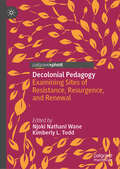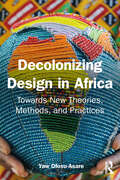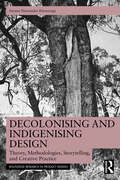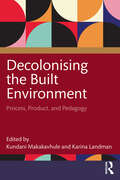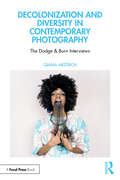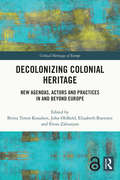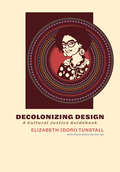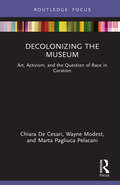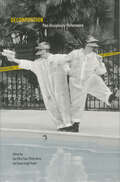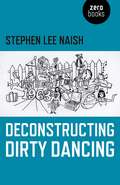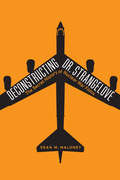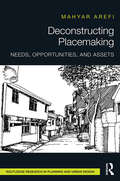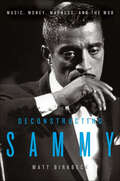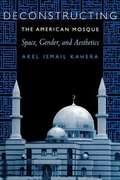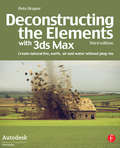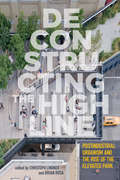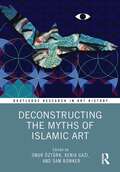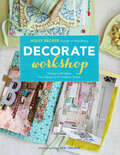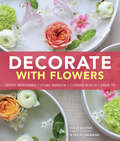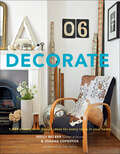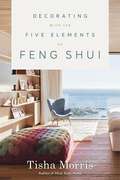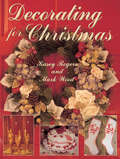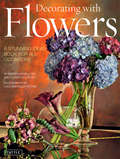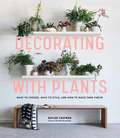- Table View
- List View
Decolonial Pedagogy: Examining Sites of Resistance, Resurgence, and Renewal
by Njoki Nathani Wane Kimberly L. ToddThrough innovative and critical research, this anthology inquires and challenges issues of race and positionality, empirical sciences, colonial education models, and indigenous knowledges. Chapter authors from diverse backgrounds present empirical explorations that examine how decolonial work and Indigenous knowledges disrupt, problematize, challenge, and transform ongoing colonial oppression and colonial paradigm. This book utilizes provocative and critical research that takes up issues of race, the shortfalls of empirical sciences, colonial education models, and the need for a resurgence in Indigenous knowledges to usher in a new public sphere. This book is a testament of hope that places decolonization at the heart of our human community.
Decolonising Design in Africa: Towards New Theories, Methods, and Practices
by Yaw Ofosu-AsareDecolonising Design in Africa offers a groundbreaking exploration of design education in Africa through a decolonial lens. By examining the colonial legacies that have shaped design education in Africa, it foregrounds the problematic ways that current pedagogical approaches primarily reflect western values and priorities. This book advocates for integrating Indigenous knowledge, cultural practices, and philosophies into contemporary African design education. It spans a wide geographical and temporal range, from historical analyses of colonial influences to envisioning decolonised African design futures. It delves into diverse aspects including spirituality in design, cultural symbolism, sustainable practices, and the ethical dimensions of decolonising design.Pioneering in its interdisciplinary approach, the book weaves together theoretical discussions, methodological innovations like storytelling, and practical strategies for curriculum reform. It presents inspiring case studies of designers and educators who are actively decolonising their practices. Decolonising Design in Africa is a vital resource for design educators, students, practitioners, and policymakers, not just in Africa but worldwide. It makes a compelling case for reimagining design education in a more inclusive, contextually relevant and socially conscious way. The book's ultimate aim is to cultivate a new generation of designers equipped to address the complex challenges of a decolonising world.
Decolonising and Indigenising Design: Theory, Methodologies, Storytelling, and Creative Practice (Routledge Research in Product Design)
by Desiree Hernandez IbinarriagaThis book offers a new approach to design theory and practice that draws on Indigenous knowledges, methodologies and methods, presenting concepts of decolonising and Indigenous design that are interweaved as theory, storytelling, and practices.The arena of design sustainability, social design, and innovation has been a site of debate since the 1960s. Yet, the ways in which design has redefined this complex realm has not directly addressed Indigenous ways of being, knowing, and doing, which could be of paramount importance to the transformation of the design field and beyond in creative practices. In response, this book offers valuable insights into how design practitioners can incorporate Indigenous practices to decolonise education, research, and design, and dismantle colonised paradigms, ways of thinking and practice in design. This approach is presented through storytelling, theory, methodology, methods, and practical examples to enlighten the reader. The book proposes a transformation in the role designers play, through understanding relationality between people, land, and the immaterial, while giving voice and agency to the land and waters, Our Mother Earth. Design is considered as a way to harness opportunities through the deep connection between people and Place, and the book critically promotes a more contextual and dynamic understanding of decolonising and Indigenising design practices and spaces through relational design.This book will be useful for students and scholars studying in the fields of design, art, architecture, culture, decolonising methodologies, biocultural diversity, and design beyond human and materiality.
Decolonising the Built Environment: Process, Product, and Pedagogy
by Karina Landman Kundani MakakavhuleDecolonising the Built Environment: Process, Product, and Pedagogy provides an important and much-needed comprehensive overview of how decolonisation is shaping the built environment in theory, in practice, and as a process/project today. The contributors provide an inclusive and trans-national conversation between a diverse set of academics, design practitioners and thinkers, and activists. This book is structured around three thematic and practical categories: Part 1 studies decolonisation conceptually; Part 2 studies decolonisation as a process; and Part 3 studies the products of decolonisation as materialised in the form of buildings, urban design, planning, policy, and social practices.Essential reading for students, teachers, and practitioners, this book presents the project of decolonisation as a pedagogy and an ongoing process.
Decolonization and Diversity in Contemporary Photography: The Dodge & Burn Interviews
by Qiana MestrichFocusing on fine art and documentary photography, this book provides a racially diverse and culturally inclusive version of photography history and its contemporary manifestations.Who’s documenting the evolution of photography as it is happening now from an inclusive, transnational perspective? This is the challenge this book aims to address. The collection is the print manifestation of the Dodge and Burn art photography blog actively published from 2007 to 2018, including a selection of 35 interviews with photographers and art professionals from underrepresented communities—those of African, Asian, Latinx/é and Native American heritage. It captures fascinating accounts of artists of color and the broad range of their challenges and successes: aspirations, photo series and photobooks, earning a living, discrimination, photography education, photographic practice, socio-political conversations, and more.Decolonization and Diversity in Contemporary Photography is a powerful collection that celebrates and exhibits the talents of underrepresented artists. It is essential reading for both photography students and aspiring photographers.
Decolonizing Colonial Heritage: New Agendas, Actors and Practices in and beyond Europe (Critical Heritages of Europe)
by Britta Timm Knudsen Elizabeth Buettner John Oldfield Elvan ZabunyanDecolonizing Colonial Heritage explores how different agents practice the decolonization of European colonial heritage at European and extra-European locations. Assessing the impact of these practices, the book also explores what a new vision of Europe in the postcolonial present could look like. Including contributions from academics, artists and heritage practitioners, the volume explores decolonial heritage practices in politics, contemporary history, diplomacy, museum practice, the visual arts and self-generated memorial expressions in public spaces. The comparative focus of the chapters includes examples of internal colonization in Europe and extends to former European colonies, among them Shanghai, Cape Town, and Rio de Janeiro. Examining practices in a range of different contexts, the book pays particular attention to sub-national actors whose work is opening up new futures through their engagement with decolonial heritage practices in the present. The volume also considers the challenges posed by applying decolonial thinking to existing understandings of colonial heritage. Decolonizing Colonial Heritage examines the role of colonial heritage in European memory politics and heritage diplomacy. It will be of interest to academics and students working in the fields of heritage and memory studies, colonial and imperial history, European studies, sociology, cultural studies, development studies, museum studies, and contemporary art.
Decolonizing Design: A Cultural Justice Guidebook
by Elizabeth (Dori) TunstallA guidebook to the institutional transformation of design theory and practice by restoring the long-excluded cultures of Indigenous, Black, and People of Color communities.From the excesses of world expositions to myths of better living through technology, modernist design, in its European-based guises, has excluded and oppressed the very people whose lands and lives it reshaped. Decolonizing Design first asks how modernist design has encompassed and advanced the harmful project of colonization—then shows how design might address these harms by recentering its theory and practice in global Indigenous cultures and histories.A leading figure in the movement to decolonize design, Dori Tunstall uses hard-hitting real-life examples and case studies drawn from over fifteen years of working to transform institutions to better reflect the lived experiences of Indigenous, Black, and People of Color communities. Her book is at once enlightening, inspiring, and practical, interweaving her lived experiences with extensive research to show what decolonizing design means, how it heals, and how to practice it in our institutions today.For leaders and practitioners in design institutions and communities, Tunstall&’s work demonstrates how we can transform the way we imagine and remake the world, replacing pain and repression with equity, inclusion, and diversity—in short, she shows us how to realize the infinite possibilities that decolonized design represents.
Decolonizing the Museum: Art, Activism, and the Question of Race in Curation (Museums in Focus)
by Wayne Modest Chiara De Cesari Marta Pagliuca PelacaniThis book asks what it means to decolonize museums in theory and practice. It explores recent calls by activists and artists for social change in and through museums and how museums have responded to these calls and interventions.The point of departure for this volume is the burgeoning global debates around racism that have compelled many museums and public institutions to confront their complicity in colonialism, both past and present. Building on interviews with curators, cultural practitioners, activists, and artists, as well as the authors' ongoing involvement with movements aimed at decolonizing museums, this volume explores how anti-racist activism and artivism have transformed museums, as well as the broader social and political significance of these transformations. The book focuses on the practices, approaches, and strategies that are being adopted in efforts to decolonize museums and cultural institutions, where they succeed and fail, and the similarities and differences between these initiatives. It discusses specific exhibitions and whether they represent colonialism as a past phenomenon or as enduring racial logics forcefully shaping the present. It analyzes both mainstream European museums and grassroots, museum-like initiatives that aim to reckon with colonialism and race in different contexts. Core to the argument is the issue of how memory, heritage, and museum studies, the disciplines that explore, explain, and staff museums, have engaged or not with race.Decolonizing the Museum will be valuable for those studying or researching in the fields of museum studies, heritage, memory and art studies, decolonial theory, postcolonialism, race and racism, and cultural politics. Providing an important window into the political role of curators and the politics of race in transforming museums, it will also be beneficial to museum practitioners and activists and artists with a stake in these institutions.
Decomposition: Post-Disciplinary Performance (Unnatural Acts: Theorizing the Performative)
by Sue-Ellen Case, Philip Brett, and Susan Leigh Foster“A collection of essays in a variety of disciplines that confront oppressed, marginalized, and invisible space . . . an astonishing array of material.” —Theatre Research InternationalThe fluid nature of performance studies and the widening embrace of the idea of performativity have come together in Decomposition to produce a collection that crosses disciplinary lines of academic work. The essays move from the local to the global, from history to sport, from body parts to stage productions, and from race relations to global politics.In the title essay, Elizabeth Wood writes about a basic human relation cast around the question of performance and triangulated by the role that a great performer took within it. Together these essays pursue critical understandings of performance in our postmodern world.Contributors include Philip Brett, Sue-Ellen Case, Susan Leigh Forster, Amelia Jones, Kristine C. Kuramitsu, George Lipsitz, Catherine Lord, Ronald Radano, Timothy D. Taylor, Jeffrey Tobin, Deborah Wong, Elizabeth Wood, and B. J. Wray“Presents interpretive interventions of a more localized, materially and institutionally anchored, and ultimately more specific and powerful nature.” —TDR/The Drama Review
Deconstructing Dirty Dancing
by Stephen Lee NaishRenowned film critic Roger Ebert said Dirty Dancing "might have been a decent movie if it had allowed itself to be about anything." In this broadly researched and accessible text, Stephen Lee Naish sets out to deconstruct and unlock a film that has haunted him for decades, and argues that Dirty Dancing, the 1987 sleeper hit about a young middle-class girl who falls for a handsome working-class dance instructor, is actually about everything. The film is a union of history, politics, sixties and eighties culture, era-defining music, class, gender, and race, and of course features one of the best love stories set to film. Using scene-by-scene analyses, personal interpretation, and comparative study, it's time to take Dirty Dancing out of the corner and place it under the microscope.
Deconstructing Dr. Strangelove: The Secret History of Nuclear War Films
by Sean M. MaloneyKing of the Cold War crisis film, Dr. Strangelove became a cultural touchstone from the moment of its release in 1964. The duck-and-cover generation saw it as a satire on nuclear issues and Cold War thinking. Subsequent generations, removed from the film&’s historical moment, came to view it as a quasi-documentary about an unfathomable secret world. Sean M. Maloney uses Dr. Strangelove and other genre classics like Fail Safe and The Bedford Incident to investigate a curious pop cultural contradiction. Nuclear crisis films repeatedly portrayed the failures of the Cold War&’s deterrent system. Yet the system worked. What does this inconsistency tell us about the genre? What does it tell us about the deterrent system, for that matter? Blending film analysis with Cold War history, Maloney looks at how the celluloid crises stack up against reality—or at least as much of reality as we can reconstruct from these films with confidence. The result is a daring intellectual foray that casts new light on Dr. Strangelove, one of the Cold War era&’s defining films.
Deconstructing Placemaking: Needs, Opportunities, and Assets
by Mahyar ArefiA new taxonomy of placemaking is needed; concerns have been expressed about the professionalization of placemaking through the proliferation of standards, zoning codes, and restrictive covenants. "Place matters" has become a mantra in many disciplines - architecture, urban planning and urban design, geography, and sociology to name a few. While conceptualized narrowly by individual disciplines, a holistic framework of placemaking is sorely missing. Mahyar Arefi seeks to fill this gap by exploring these questions: how are places physically created, socially mobilized, and politically contested? This book explores three competing approaches to placemaking: need-based, opportunity-based, and asset-based. Using a case study approach, the book delves into each paradigm and its stages of physical formation, social mobilization, and political contestation.
Deconstructing Sammy: Music, Money, and Madness
by Matt BirkbeckSammy Davis Jr. lived a storied life. Adored by millions over a six-decade-long career, he was considered an entertainment icon and a national treasure. But despite lifetime earnings that topped $50 million, Sammy died in 1990 near bankruptcy. His estate was declared insolvent, and there was no possibility of itever using Sammy's name or likeness again. It was as if Sammy had never existed. Years later his wife, Altovise, a once-vivacious woman and heir to one of the greatest entertainment legacies of the twentieth century, was living in poverty, and with nowhere else to go, she turned to a former federal prosecutor, Albert "Sonny" Murray, to make one last attempt to resolve Sammy's debts, restore his estate, and revive his legacy. For seven years Sonny probed Sammy's life to understand how someone of great notoriety and wealth could have lost everything, and in the process he came to understand Sammy as a man whose complexity makes for a riveting work of celebrity biography as cultural history.Matt Birkbeck's serious work of investigative journalism unveils the extraordinary story of an international celebrity at the center of a confluence of entertainment, politics, and organized crime, and shows how even Sammy's outsized talent couldn't save him from himself.
Deconstructing the American Mosque
by Akel Ismail KaheraFrom the avant-garde design of the Islamic Cultural Center in New York City to the simplicity of the Dar al-Islam Mosque in Abiquiu, New Mexico, the American mosque takes many forms of visual and architectural expression. The absence of a single, authoritative model and the plurality of design nuances reflect the heterogeneity of the American Muslim community itself, which embodies a whole spectrum of ethnic origins, traditions, and religious practices. In this book, Akel Ismail Kahera explores the history and theory of Muslim religious aesthetics in the United States since 1950. Using a notion of deconstruction based on the concepts of "jamal" (beauty), "subject," and "object" found in the writings of Ibn Arabi (d. 1240), he interprets the forms and meanings of several American mosques from across the country. His analysis contributes to three debates within the formulation of a Muslim aesthetics in North America-first, over the meaning, purpose, and function of visual religious expression; second, over the spatial and visual affinities between American and non-American mosques, including the Prophet's mosque at Madinah, Arabia; and third, over the relevance of culture, place, and identity to the making of contemporary religious expression in North America.
Deconstructing the Elements with 3ds Max: Create natural fire, earth, air and water without plug-ins
by Pete Draper3ds Max is the leading 3D modeling, animation, and rendering solution for artists, schools, and production environments. The unique tutorial approach of this book permits readers to learn essential techniques that every 3D artist needs to create CG environments by recreating the earth's elements of earth, air, fire and water. No extra plug-ins are required to perform the exercises. Draper studies the real world and then simlates it with 3ds Max -a unique approach that reflects classical art training."Deconstructing the Elements" allows artists to re-create natural effects using Autodesk® 3ds Max®. This new edition boasts all new tutorials. All editorial content is updated to be current with the current version of 3ds Max. Inspirational images cover every page as the author shares his professional insight, detailing the how and why of each effect, ensuring the reader a complete understanding of all the processes involved. The companion web site includes all of the tutorials from the previous two editions, only available to purchasers of this 3rd edition - plus all new tutorials of the current edition. It's like getting 3 books in one!
Deconstructing the High Line: Postindustrial Urbanism and the Rise of the Elevated Park
by Alan Smart Brian Rosa Christoph Lindner Daan Wesselman Danya Sherman Darren Patrick James Corner Julian Brash Kevin Loughran Nate Millington Phil Birge-Liberman Scott Larson Tom BakerThe High Line, an innovative promenade created on a disused elevated railway in Manhattan, is one of the world’s most iconic new urban landmarks. Since the opening of its first section in 2009, this unique greenway has exceeded all expectations in terms of attracting visitors, investment, and property development to Manhattan’s West Side. Frequently celebrated as a monument to community-led activism, adaptive re-use of urban infrastructure, and innovative ecological design, the High Line is being used as a model for numerous urban redevelopment plans proliferating worldwide.Deconstructing the High Line is the first book to analyze the High Line from multiple perspectives, critically assessing its aesthetic, economic, ecological, symbolic, and social impacts. Including several essays by planners and architects directly involved in the High Line’s design, this volume also brings together a diverse range of scholars from the fields of urban studies, geography, anthropology, sociology, and cultural studies. Together, they offer insights into the project’s remarkable success, while also giving serious consideration to the critical charge that the High Line is “Disney World on the Hudson,” a project that has merely greened, sanitized, and gentrified an urban neighborhood while displacing longstanding residents and businesses.Deconstructing the High Line is not just for New Yorkers, but for anyone interested in larger issues of public space, neoliberal redevelopment, creative design practice, and urban renewal.
Deconstructing the Myths of Islamic Art (Routledge Research in Art History)
by Onur ÖztürkDeconstructing the Myths of Islamic Art addresses how researchers can challenge stereotypical notions of Islam and Islamic art while avoiding the creation of new myths and the encouragement of nationalistic and ethnic attitudes. Despite its Orientalist origins, the field of Islamic art has continued to evolve and shape our understanding of the various civilizations of Europe, Africa, Asia, and the Middle East. Situated in this field, this book addresses how universities, museums, and other educational institutions can continue to challenge stereotypical or homogeneous notions of Islam and Islamic art. It reviews subtle and overt mythologies through scholarly research, museum collections and exhibitions, classroom perspectives, and artists’ initiatives. This collaborative volume addresses a conspicuous and persistent gap in the literature, which can only be filled by recognizing and resolving persistent myths regarding Islamic art from diverse academic and professional perspectives. The book will be of interest to scholars working in art history, museum studies, visual culture, and Middle Eastern studies.
Decor and the Single Girl: How to Design Your Life Around the Relationship You Want
by Karrine SteffansWhen your living space is attractive and inviting, guests respond. As a single woman, this is especially true for potential suitors you allow into that space. After all, how can he imagine himself in your life if he's not comfortable in your home? As your life changes, your decor changes and you must design your life around the relationship you desire and deserve. Your style doesn't just communicate who you are; it also tells people who you want to be. If you're a single woman looking to make a real connection, it's time to make sure your decor sends the right message. Decor and the Single Girl, by New York Times bestselling author Karrine Steffans, is a beautifully photographed guide for today's single woman ready to make room in her life for a man. But, before she makes that room, she has to decorate it—and not for the life she has, but for the life she wants! Each chapter offers easy, straight to the point, comprehensive advice, as well as helpful shopping links, and even quick quips on how to recognize when it's time to dump a man who may be unappreciative of the hard work a single girl goes through to make her home appealing and comfortable. From the first date to the day he or she moves in, Decor and the Single Girl helps the modern woman appreciate what a touch of traditionalism and forward planning can mean to her dating life and relationships.
Decorate Workshop: Design and Style Your Space in 8 Creative Steps
by Holly Becker“A veritable bible for design fanatics . . . this combination design book and interactive guide will take you to that finished space you’ve been dreaming of.” —Glitter GuideHolly Becker, founder of Decor8, shares all of the design secrets that have made her one of the most beloved bloggers and stylists today. A companion to the international bestseller Decorate, this interactive guide takes readers step by step through her unique eight-part process. She shares her personal design philosophy and explains how to carry a vision into a finished room, from the early paint swatches to the final accents. Readers will learn how to identify their style, create mood boards, outline a schedule and budget, source materials, and start decorating! Filled with expert tips, important checklists, blank space for making lists and plans, and 250 photographs of gorgeous interiors, this is an essential planner for home decorators, whatever their budget.“Becker . . . gives practical tips on how to take a space from vision to completion.” —Apartment Therapy“Unlike some interior design books which are just full of lovely photographs, Decorate Workshop pairs those inspirational images with eight steps to walk you through your next decorating dilemma.” —Mint“The process Holly has come up with is really practical and is a brilliant way to approaching your space.” —Poppytalk“I absolutely love the format of this ‘workbook’ which provides a step-by-step look at planning and executing decorating projects.” —The TomKat Studio
Decorate with Flowers: Gorgeous Arrangements, Creative Displays, And Diy Projects For Styling Your Home With Plants And Flowers
by Holly Becker Leslie Shewring“A beautiful book packed with original full-color photography that can inspire even the least green fingered of people with its creative ideas.” —The Design SheppardIn this gorgeous and unique book, Decorate author Holly Becker teams up with stylist Leslie Shewring to offer practical know-how and colorful inspiration for decorating the home with florals. Beginning with the basics of flower arranging and progressing on to decorating ideas for a range of styles—such as vintage, eclectic, and modern—with creative DIY flower and container projects peppered throughout, this book offers a bunch of fresh ideas for flower enthusiasts and home decorators on any budget.“When the brand-new book Decorate with Flowers landed on our desk, we wanted to fill our house with flowers. Botanical buffs Holly Becker and Leslie Shewring collaborated to create the wildly inspirational book.” —InStyle“A book that is beautiful and inspiring!” —Barb Blair, author of Furniture Makeovers“You’re going to love all the ideas this book has to offer.” —Poppytalk“I love the newest book by Holly Becker and Leslie Shewring. Flowers are probably one of my favorite things in the world, and the inspiration and DIYs in this book are beautiful and inspiring.” —Joy Cho, founder of Oh Joy!“The book is abloom with smart tips and unusual arrangement ideas.” —One Kings Lane®
Decorate: 1,000 Professional Design Ideas for Every Room in Your Home
by Joanna Copestick Holly Becker“[An] amazing interior design bible . . . It’s full of inspirational creative advice and really is a feast for the eyes!” —FloweronaIn Decorate, the world’s top designers and leading decor experts including Kelly Wearstler, Amy Butler, Jonathan Adler, and many others come together to share over 1,000 professional tips, ideas, and solutions for every room and every budget. Written and compiled by Holly Becker, founder of the hugely popular design blog Decor8, and Joanna Copestick, acclaimed lifestyle writer, this intensive home décor program combines beautiful inspiration with nuts-and-bolts how-to for stunning results. More than five hundred gorgeous color photographs provide motivation while line illustrations, checklists, shortcuts, and floor plans make it easy to get started. For those looking to make the most of their home and create stylish interiors, Decorate is the start-to-finish resource to keep on the bookshelf for years to come.“It’s like your first pack of Starbursts—exploding with color, homes and sunshine in equal measure.” —Apartment Therapy“If you are a serial decorator like me you’re always looking for the next big idea and it’s lovely to have a compendium at your fingertips to use as a guide as well as inspiration . . . full of decorating ideas from some of today’s most interesting and creative minds. Add to that the stunning photography by Debi Treloar and you have all you need to make informed decisions and choose the look that suits your lifestyle and situation the best.” —Dear Designer’s Blog“Holly’s eye for amazing design, drool-worthy decor and everything in-between has captured the blog world’s attention.” —Bucks County Courier Times
Decorating With the Five Elements of Feng Shui
by Tisha MorrisBalance your energy, improve your relationships and happiness, and heal your living space and the planet. Join feng shui expert Tisha Morris as she reveals the amazing possibilities for transformation when you use five elements wisdom to make simple yet beautiful changes in your home and life.The five elements—Wood, Fire, Earth, Metal, Water—are the threads of energy that connect all living beings with nature. Learn how each element is expressed not only in nature, but also through you and your home. Start with a quiz to understand your elemental makeup. Then follow the three-step formula to incorporate feng shui into your life. With a room-to-room guide for using the five elements, instructions for healing spaces both inside and outside, and much more, Decorating With the Five Elements of Feng Shui will help you find harmony in your body, your home, and the world.
Decorating for Christmas
by Kasey Rogers Mark WoodThe holiday craft team of Kasey Rogers and Mark Wood supply do-it-yourselfers with grand Christmas projects to spruce up the home during this festive season. This team whips up some elegant decorations from the rustic nostalgia of their Country Cabin Christmas to the tradition of a red and white Candy Cane Christmas. Step-by-step instructions show how to create a children's table featuring whimsical toy soldier designs on a tablecloth, centerpiece, curtains, and pillows, as well as a winter wonderland with snowmen and cone shaped trees. The festive projects were beautifully photographed in vintage home settings.
Decorating with Flowers
by Elizabeth Reyes Luca Invernizzi Tettoni Roberto CaballeroUse fresh flowers to make a dramatic difference in your home...and dazzle with the power of flowers when you entertain! Decorating with Flowers celebrates the latest trends in contemporary floral design with a tropical twist. Featuring inspired table settings and installations, this extraordinary book will encourage you to create your own unforgettable floral creations every time you entertain!The ten designers and artists showcased share the ideas and insights behind their creations--each of which is shown in detailed photos--making this an excellent guide for interior decorators, florists, event planners and homeowners looking to add some pizzaz to a space.Featuring over 300 color photographs, Decorating with Flowers has something for everyone-from glamorous Flemish floral arrangements to modern Sogetsu ikebana styles, and modular flower sculptures created to enhance minimalist, contemporary spaces.
Decorating with Plants: What to Choose, Ways to Style, and How to Make Them Thrive
by Baylor ChapmanHouseplants are more popular than ever before—especially with millennials, who are setting up their homes for the first time and discovering that nothing can add energy, style, and that essential “lived-in-ness” to their spaces better than a little bit of green. Whether it’s a statement-making fiddle-leaf fig or a tiny tabletop succulent, a houseplant instantly elevates the look of your home. But where to begin? In Decorating with Plants, Baylor Chapman walks readers through everything they need to know to bring houseplants into their home. First, there’s Plant Care 101: from how to assess light conditions to tricks for keeping your plants alive while on vacation, Chapman gives readers the simple, foundational info they need to ensure their plants will thrive. Then she introduces us to 28 of her favorites—specimens that are tough as nails but oh-so-stylish, from the eye-catching Rubber Tree to the delicate Cape Primrose. Finally, she guides readers through the home room by room: Place an aromatic plant like jasmine or gardenia to your entry to establish your home’s “signature scent.” Add a proper sense of scale to your living room with a ceiling-grazing palm. Create a living centerpiece of jewel-toned succulents for a dining table arrangement that will last long after your dinner party. From air purification to pest control, there’s no limit to what houseplants can do for your home—and Decorating with Plants is here to show you how to add them to spaces big and small with style.
